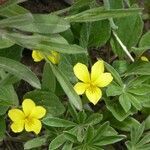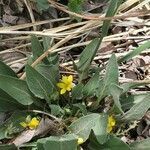Plants perennial, caulescent, not stoloniferous, 2–27 cm. Stems 1–6, ascending to erect, leafy proximally and distally, ca. 1/2 subterranean, puberulent, on caudex from usually vertical, subligneous rhizome. Leaves basal and cauline; basal: 1–6; stipules adnate to petiole, forming 2 linear-lanceolate wings, margins entire, apex of each wing free, acute, few-toothed or lobed; petiole 2–17 cm, glabrous or minutely puberulent; blade lanceolate, ovate, or elliptic, 1–9 × 0.6–2.5 cm, base attenuate, margins entire or serrulate, sometimes sinuate, ciliate, apex acute to obtuse, mucronulate, surfaces glabrous or puberulent; cauline similar to basal except: stipules adnate to or free from petiole, linear to linear-lanceolate or linear-oblong, sometimes leaflike, margins usually entire, rarely laciniate or glandular, apex acute to acuminate; petiole 2–7 cm; blade 1.4–7.2(–10) × 1.1–2.3 cm, length 1.3–4.4 times width, apex acute. Peduncles 3–13 cm, glabrous or puberulent. Flowers: sepals linear-lanceolate, margins eciliate, auricles 0.5–1 mm; petals deep lemon-yellow adaxially or on both surfaces, upper 2 often brownish purple abaxially, lower 3 dark brown-to brownish purple-veined, lateral 2 sparsely bearded, lowest 6–13 mm, spur yellow, gibbous, 0.5–1.5 mm; style head bearded; cleistogamous flowers axillary. Capsules subglobose to ovoid, 4–10 mm, usually glabrous, rarely finely puberulent. Seeds medium brown, 2–3.2 mm, elaiosome extending over 1/3 length of seed and completely covering funiculus. 2n = 24.
More
Finely hairy to subglabrous, with numerous ascending stems to 1(–1.5) dm from a stout, deep-seated rhizome; stems bearing lvs and fls from near the base; lf-blades mostly lanceolate or lance-elliptic, varying to sometimes lance-ovate, 2–6 cm, tapering (seldom more abruptly contracted) to petioles nearly or quite as long, mostly (2–)2.5–6 times as long as wide; fls 1–1.5 cm wide, the pet yellow, with brown-purple lines near the base and often purplish-tinged outside, the lateral pet beardless or slightly bearded; style-head bearded; frs subglobose or ellipsoid, 6–8 mm; 2n=24. Prairies and plains; widespread in the w. cordillera and e. onto the Great Plains, reaching Kans., Nebr., S.D., and w. Minn. Apr.–July. The plains plants, as here described, are var. nuttallii. Several other vars., differing in ploidy-level and in form, size, and vestiture of the lvs, occur farther w.



